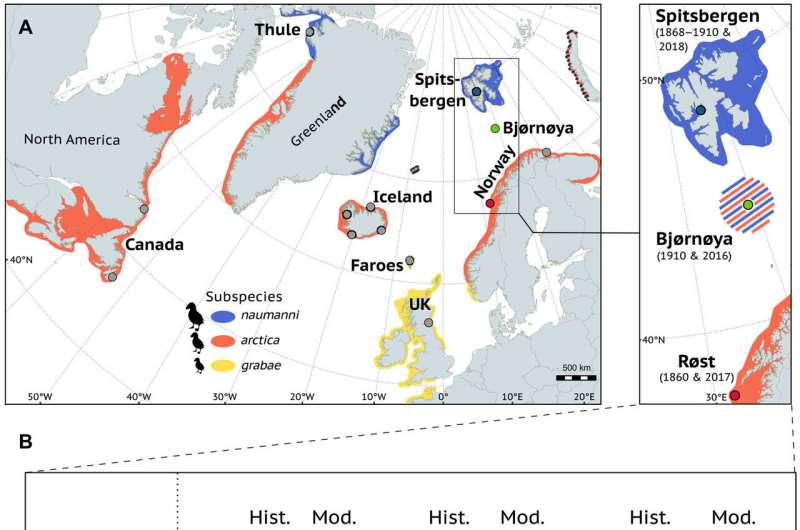October 9, 2023 report
This article has been reviewed according to Science X's editorial process and policies. Editors have highlighted the following attributes while ensuring the content's credibility:
fact-checked
peer-reviewed publication
trusted source
proofread
Hybridization of Atlantic puffins in the Arctic coincides with 20th-century climate change

A team of ecologists and evolutionary scientists at the University of Oslo, working with colleagues from the Norwegian Institute for Nature Research, the Norwegian Polar Institute, the Swedish Museum of Natural History, and the American Museum of Natural History, has found that two subspecies of Atlantic puffin that historically have lived far apart began intermingling over the past century, resulting in the development of a new hybrid puffin species.
In their study, reported in the journal Science Advances, the group conducted a genetic analysis of the new species and of the two subspecies that appear to have mixed to create them.
The work involved temporarily capturing specimens and collecting blood samples from a colony of puffins living on an island off the coast of Norway called Spitsbergen, in Svalbard. Genetic testing of the samples showed that they were a mix of two subspecies of puffin, one of which lives on Bear Island. They compared the results with 22 samples taken from puffins living on several other islands in the area over the years 1868 to 1910. They also analyzed more recent samples collected from puffins on other nearby islands over the years 2012 to 2018.
The research team found that prior to 1910, all the puffins living on Bear Island belonged to the species F. a. artica and all the puffins living on a few other somewhat distant islands, belonged to the species F. a. naumanni. They also found that the new species came about after 1910 due to comingling of F. a. arctica and F. a. naumanni. The research team also found that prior to 1910, the earliest common ancestor for the two species was approximately 40,000 years ago.
Taken together, the researchers found that the evidence suggests something caused F. a. naumanni to begin traveling farther south than it ever had prior to 1910, and that brought it into contact with F. a. artica, resulting in a mixed species living on the island of Spitsbergen. They suggest the likely cause was climate change.
More information: Oliver Kersten et al, Hybridization of Atlantic puffins in the Arctic coincides with 20th-century climate change, Science Advances (2023). DOI: 10.1126/sciadv.adh1407
Journal information: Science Advances
© 2023 Science X Network



















